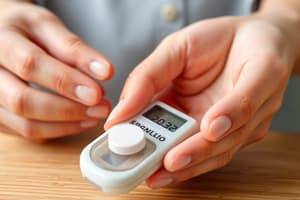Podcast
Questions and Answers
What is the primary objective of the A.S.P.E.N. Clinical Guideline?
What is the primary objective of the A.S.P.E.N. Clinical Guideline?
- To compare the effects of parenteral and enteral nutrition on blood glucose levels
- To provide guidelines for glucose control in adults receiving nutrition support (correct)
- To establish a universal blood glucose goal range for all patients
- To investigate the causes of hyperglycemia in hospitalized patients
What is the consequence of attempting to correct hyperglycemia in hospitalized patients?
What is the consequence of attempting to correct hyperglycemia in hospitalized patients?
- Diabetes
- Malnutrition
- Hyperglycemia
- Hypoglycemia (correct)
What is the recommended target blood glucose goal range for adult hospitalized patients receiving nutrition support?
What is the recommended target blood glucose goal range for adult hospitalized patients receiving nutrition support?
- 100–120 mg/dL
- 140–180 mg/dL (correct)
- 180–200 mg/dL
- 120–140 mg/dL
What is the method used to develop the A.S.P.E.N. Clinical Guideline recommendations?
What is the method used to develop the A.S.P.E.N. Clinical Guideline recommendations?
What is the definition of hypoglycemia in adult hospitalized patients receiving nutrition support?
What is the definition of hypoglycemia in adult hospitalized patients receiving nutrition support?
What is the purpose of using diabetes-specific enteral formulas in hospitalized patients?
What is the purpose of using diabetes-specific enteral formulas in hospitalized patients?
Study Notes
Hyperglycemia and Nutrition Support
- Hyperglycemia is a common occurrence in adult hospitalized patients receiving nutrition support.
- Both hyperglycemia and hypoglycemia are associated with adverse outcomes in diabetic and nondiabetic patients.
Guidelines for Glucose Control
- The American Society for Parenteral and Enteral Nutrition (A.S.P.E.N.) recommends a target blood glucose goal range of 140–180 mg/dL (7.8–10 mmol/L) in adult hospitalized patients receiving nutrition support.
- Hypoglycemia is defined as a blood glucose concentration of <70 mg/dL (3.9 mmol/L) in adult hospitalized patients receiving nutrition support.
Development of Clinical Guideline
- A systematic review of the best available evidence was conducted to answer questions regarding glucose control in adults receiving parenteral or enteral nutrition.
- The Grading of Recommendations, Assessment, Development and Evaluation (GRADE) working group's concepts were used to evaluate the evidence.
- A consensus process was used to develop the clinical guideline recommendations, which were then reviewed and approved by the A.S.P.E.N. Board of Directors.
Studying That Suits You
Use AI to generate personalized quizzes and flashcards to suit your learning preferences.
Description
This quiz is based on the ASPEN Clinical Guideline for the desired blood glucose goal range in hospitalized patients. It covers the risks of hyperglycemia and hypoglycemia, and provides evidence-based guidelines for nutrition support.




